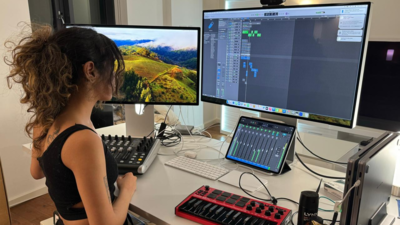Trending
Now, you can be a music producer without even leaving the bedroom
Viepsa Arora and other DIY musicians create music using digital tools from their bedrooms, blending genres and collaborating globally. This trend, characterized by unique yet complex sounds, democratizes music production. Despite the convenience, managing all aspects independently remains a challenge, often requiring brand sponsorships to sustain their passion.
Armed with a laptop and minimal equipment, young DIY artists are creating, sharing music
Viepsa Arora makes music from her bedroom, but she doesn’t use any musical instruments. Instead, she works with just a white desk, laptop, and a MIDI keyboard, using software called Logic Pro. “If you sit in front of a screen with a lot of buttons on it, eventually you’re going to learn how to play anything — you just have to experiment with it,” says the 23-year-old, who is about to release her first EP. “Ambient music sounds big and all-encompassing, which is what an artist desires when working from their bedroom — a sense of creating a room for yourself that you’re not currently in.”
Bedroom artists, as the name suggests, are do-it-yourself (DIY) musicians who create music from start to finish completely on their own. This isn’t a new phenomenon — a decade ago, artists like Prateek Kuhad and Anuv Jain were creating more intimate, stripped-down tracks with just their guitars or keyboards. This gave birth to a unique indie scene, characterised by its raw, authentic sound. Now, artists not just recording music on their own, but the entire production process happens from their bedrooms. This doesn’t mean their sound is simplistic. Today, ‘bedroom producers’ are honing their craft by playing around with the latest technology and expanding their soundscape by mixing traditional genres like Indian classical music and ghazals with western genres like UK Drum and Bass (DnB).
It’s not a lack of musical knowledge that makes artists opt for this DIY vibe. Tarana Marwah, more commonly known through her stage name Komorebi, is a prime example. She is a multi-instrumentalist formally trained in Western classical piano but considers herself a producer first. At 18, after years of singing in choirs, she bought a laptop and taught herself how to use a digital audio workstations (DAW) through online tutorials. Today, she has converted one of her rooms into a mini studio with a laptop, a field monitor, a good pair of headphones, an analog keyboard, and a Rode mic to produce her music.
Bedroom producers have a certain aesthetic. People outside India have been doing this for a while — like Grimes, who made one of her first albums on GarageBand, a music production application. The bedroom producer identity has morphed into a genre of its own, marked by lo-fi, textural, ambient, and dream pop sounds. But some are seeking to create a more unique sound. Rohan Sinha, known as Dolorblind, says, “With everyone using the same samples and the same DAWs, there will inevitably be a similar sounding sphere,” adds Sinha, who began his musical journey on a Kanye West forum, where he connected with a hip-hop producer who mentored him by sending samples to work with. To keep his music fresh and distinctive, Sinha experiments with recording samples from ‘non-music objects’ including sounds from chains and doors.
The beautiful thing about production is that there are no rules. The artist doesn’t need to know how to play any instruments or formal music theory. They can use digital instruments and modern processing to create samples. The accessibility of music production technology has democratised the industry, allowing anyone with a computer to produce and distribute their music. This shift has not only changed how music is made but also who gets to make it — leading to a significant rise in the number of women in music production. Yet, as liberating as technology is, most go back to the basics and learn music theory and instruments.
Like other independent artists, bedroom producers, too, struggle to live off their passion. “While the idea of hyper-independence and being a DIY musician is empowering, it also comes with a lot of responsibility. Musicians have to manage everything themselves, from production to promotion, which can be overwhelming,” says Anirudh Voleti, talent manager at Represent Management. The lack of structural support for independent artists means many rely on brand sponsorships to fund live shows and concerts. “In India, people come for the alcohol and stay for the music,” says Sinha, referring to most live events being sponsored by alcohol brands. Streaming revenue alone is insufficient unless you are one of the biggest artists in the world. “If given the opportunity, most artists would prefer the backing of a major label that understands their demands. Labels are not a bad thing, greedy labels are,” says Arora.
End of Article
FOLLOW US ON SOCIAL MEDIA
Visual Stories
Tired of too many ads?go ad free now










